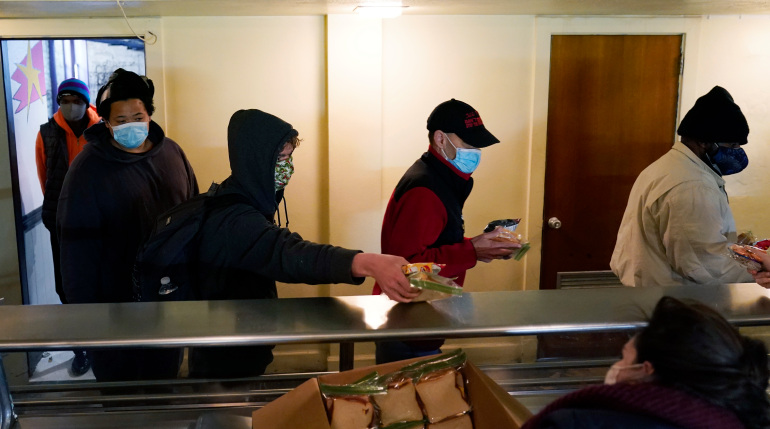Millions are without power as a winter storm grips the southern and central United States, with the death toll rising to 20 from record-breaking cold weather.
More than 20 storm-related deaths have been registered by Tuesday, as storm warnings were issued in parts of Oklahoma, Mississippi, Tennessee, Arkansas and the hardest-hit state of Texas.
More than 2,700 US flights had been cancelled by midday on Tuesday, led by two Texas airports, with more than 800 cancelled at Dallas Fort Worth International Airport and more than 700 at Bush Intercontinental in Houston.
In Texas – where freezing conditions prompted utility companies to implement rotating blackouts – a woman and girl died from carbon monoxide poisoning after using a car to generate heat, according to NBC News.
In Houston on Monday, a homeless man was killed “possibly from exposure,” according to the Harris County Sheriff’s Department, and the city’s police chief said another man had been found dead after potential exposure to low temperatures.
President Joe Biden on Tuesday vowed to provide additional emergency resources for those affected by the “historic storm.”
He also thanked “road workers, highway patrol officers, and first responders who are taking swift action in horrific conditions to save lives,” according to a White House statement.
Power grids overwhelmed
The storm that overwhelmed power grids and immobilised the Southern Plains on Tuesday carried heavy snow and freezing rain into New England and the Deep South and left behind painfully low temperatures.
Wind-chill warnings have been extended from Canada into Mexico, where four million people lost power.
The weather also threatened to affect the nation’s COVID-19 vaccination effort, with the Biden administration saying delays in vaccine shipments and deliveries were likely.
The National Weather Service was “very surprised how rapidly this storm intensified … and at the time of night when most people are at home and in bed, it creates a very dangerous situation,” Emergency Services Director Ed Conrow said.
The worst US power outages were in Texas, affecting more than 2 million homes and businesses. More than 250,000 people also lost power across parts of Appalachia, and another 200,000 were without electricity following an ice storm in northwest Oregon, according to poweroutage.us, which tracks utility outage reports.
Texas officials requested 60 generators from the Federal Emergency Management Agency and planned to prioritise hospitals and nursing homes. The state opened 35 shelters to more than 1,000 occupants, the agency said.
More than 500 people sought warmth at one Houston shelter. Mayor Sylvester Turner said other warming centres were closed because they lost power.
After losing power on Monday, Natalie Harrell said she, her boyfriend and four children sheltered at a furniture shop in Houston. The warming centre at the store provided people with food, water and power to charge essential electronics.
“It’s worse than a hurricane,” Harrell said. “I think we are going to be more days without light, that is what it seems like.”
Utilities from Minnesota to Texas implemented rolling blackouts to ease the burden on power grids straining to meet extreme demand for heat and electricity.
 People seeking shelter from sup-freezing temperatures receive a meal at a make-shift warming shelter at Travis Park Methodist Church in San Antonio [Eric Gay/AP Photo]
People seeking shelter from sup-freezing temperatures receive a meal at a make-shift warming shelter at Travis Park Methodist Church in San Antonio [Eric Gay/AP Photo]
Blackouts lasting more than an hour began around dawn on Tuesday for Oklahoma City and more than a dozen other communities, stopping electric-powered space heaters, furnaces and lights just as temperatures hovered around minus 22 degrees Celsius (-8 Fahrenheit).
Oklahoma Gas & Electric rescinded plans for more blackouts but urged users to set thermostats no higher than 20 Celsius (68 Fahrenheit), avoid using major electric appliances and turn off lights or appliances not in use.
Nebraska’s blackouts came amid some of the coldest weather on record: In Omaha, the temperature bottomed out at minus 30 Celsius (-23 Fahrenheit) overnight, the coldest in 25 years.
The Southwest Power Pool, a group of utilities covering 14 states, said the blackouts were “a last resort to preserve the reliability of the electric system as a whole.”
Severe weather affects vaccination drive
Several cities had record lows: In Minnesota, the Hibbing/Chisholm weather station registered minus 39 Celsius (minus 38 Fahrenheit). Sioux Falls, South Dakota, dropped to minus 32 Celsius (minus 26 Fahrenheit).
Authorities pleaded with residents to stay home on Tuesday. About 100 school systems closed, delayed opening or switched to remote classes in Alabama, where forecasters said conditions might not improve until temperatures rise above freezing on Wednesday afternoon.
 People wait in line to enter Fiesta supermarket on February 16, 2021 in Houston [Go Nakamura/Getty Images/AFP]
People wait in line to enter Fiesta supermarket on February 16, 2021 in Houston [Go Nakamura/Getty Images/AFP]
The outages forced a Texas county to scramble to administer more than 8,000 doses of Moderna’s coronavirus vaccine after a public health facility lost power early on Monday and its backup generator also failed, said Rafael Lemaitre, a spokesman for Harris County Judge Lina Hidalgo.
County officials distributed the doses that could have spoiled at three hospitals, Rice University and the county jail because there were large groups of people available at those locations as well as the needed medical personnel.
“It feels amazing. I’m very grateful,” said Harry Golen, a college sophomore who waited for nearly four hours with his friends, much of it in the cold, and was among the last people to get the shots, which otherwise would not have reached students until March or April.
Texas officials said more than 400,000 doses due now will not arrive until at least Wednesday because of the storm.





